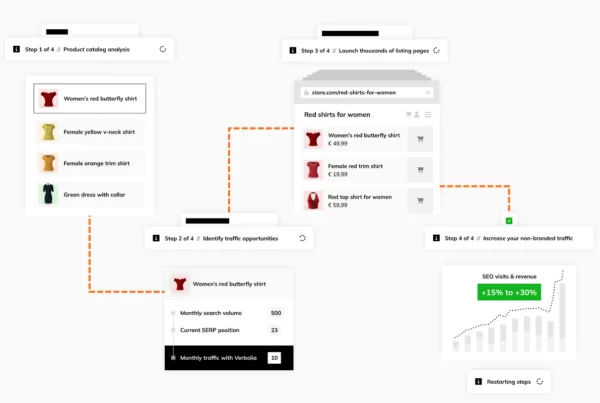Blog article
Keyword Research for Ecommerce
Estimated reading time: 10 minutes

Unlocking the power of search engine optimization (SEO) is a game-changer for any ecommerce business. Among the myriad of SEO strategies, one stands out as essential: keyword research. But how do you navigate this seemingly complex process? Buckle up, because we’re about to embark on a journey into the world of ecommerce keyword research.
The Importance of Keyword Research
Keyword research is the backbone of any successful SEO strategy. It’s like the compass that points your ecommerce business in the right direction, ensuring you attract the right audience, boost your organic traffic, and ultimately, increase your sales. The process involves identifying popular words and phrases that people enter into search engines, especially long-tail keywords.
🔍 Did you know? These long-tail keywords make up a staggering 95% of all search queries! They’re pivotal in optimizing your content, product listings, and webpages. A vital nugget to remember when you’re fine-tuning your SEO strategy! 🚀
How to pinpoint the most appropriate keywords for the products you sell?
E-commerce managers need to identify keywords that accurately represent their products and that potential customers are likely to use in search queries.
Think of yourself as a detective, analyzing your product catalog for clues. These clues lie within your product names, descriptions, attributes, and categories. The keywords could be hiding anywhere – in the “size,” “color,” “brand,” or “occasion” attributes of your products.
For instance, if you’re selling dresses, your clues might lead to long-tail keywords like “red summer maxi dresses,” “women’s green hoodies,” or “evening dresses for prom.” If shoes are your thing, you might stumble upon “women’s white sneakers,” “men’s black boots size 30,” or “kids’ sandals for summer.”
These long-tail keywords are incredibly important because they indicate a clear user intent. When users search for such specific phrases, they usually have a clear idea of what they want. As a result, if they find a website that offers exactly what they’re looking for, they’re more likely to convert. In fact, a study by Conductor found that long-tail keywords convert 2.5x higher than visitors who searched on head terms.
Once you’ve uncovered potential keywords, the next step is to see if they’re popular among searchers. Tools like Google Keyword Planner, Ahrefs, SEMrush, Moz, and Ubersuggest can help you gauge the monthly search volume.
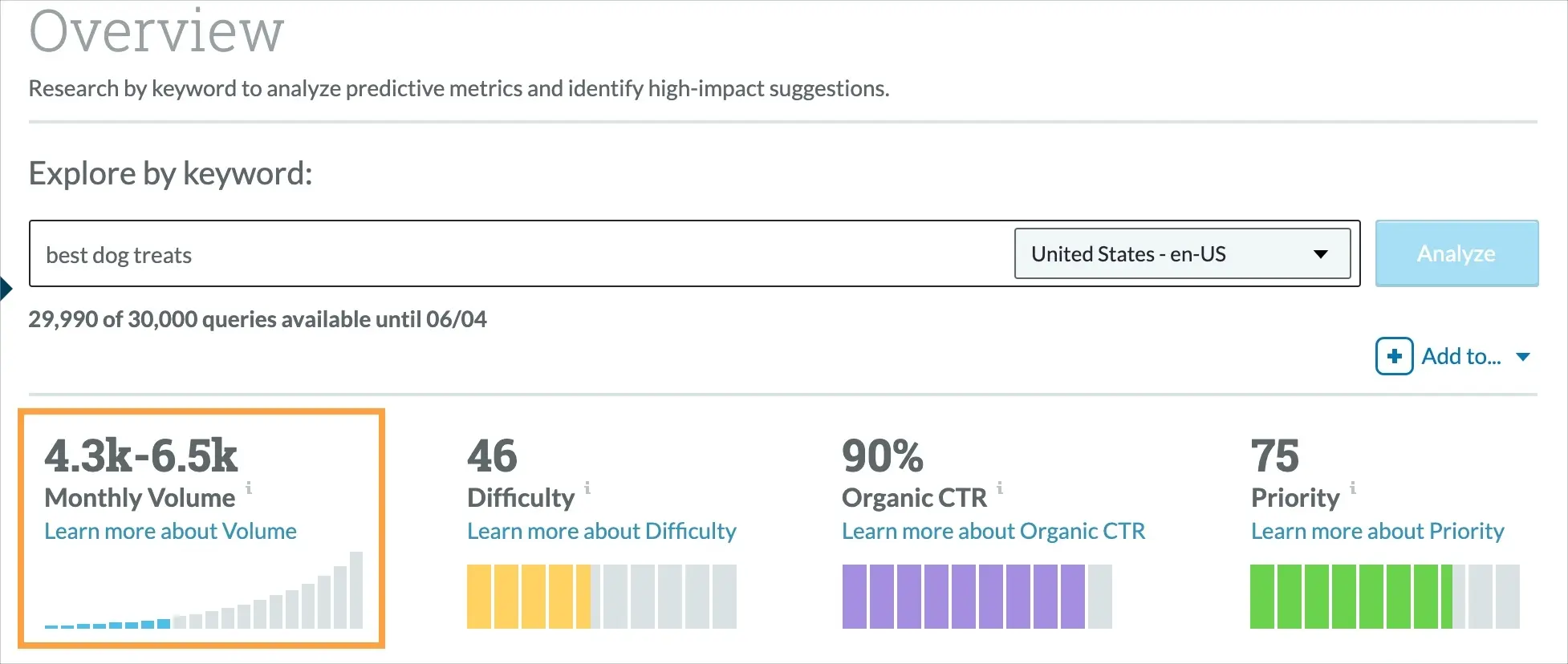
While these tools are useful, remember they aren’t infallible – particularly when it comes to long-tail keywords. These highly-specific phrases typically have lower search volumes and can be tricky to measure accurately. However, even a hint of search volume can signal that your keyword is in demand. So, don’t overlook these potential gold mines – your competitors probably are!
Digging a bit deeper, tools like Google Search Console and Bing Webmaster can shed light on the search terms already driving traffic to your site. Google Analytics, particularly the Search Term report (under Behaviour > Search Terms), can also reveal how users are seeking out your products. For those using Google Ads, peek into which keywords are triggering your Shopping Ads or Ad campaigns for additional insights.
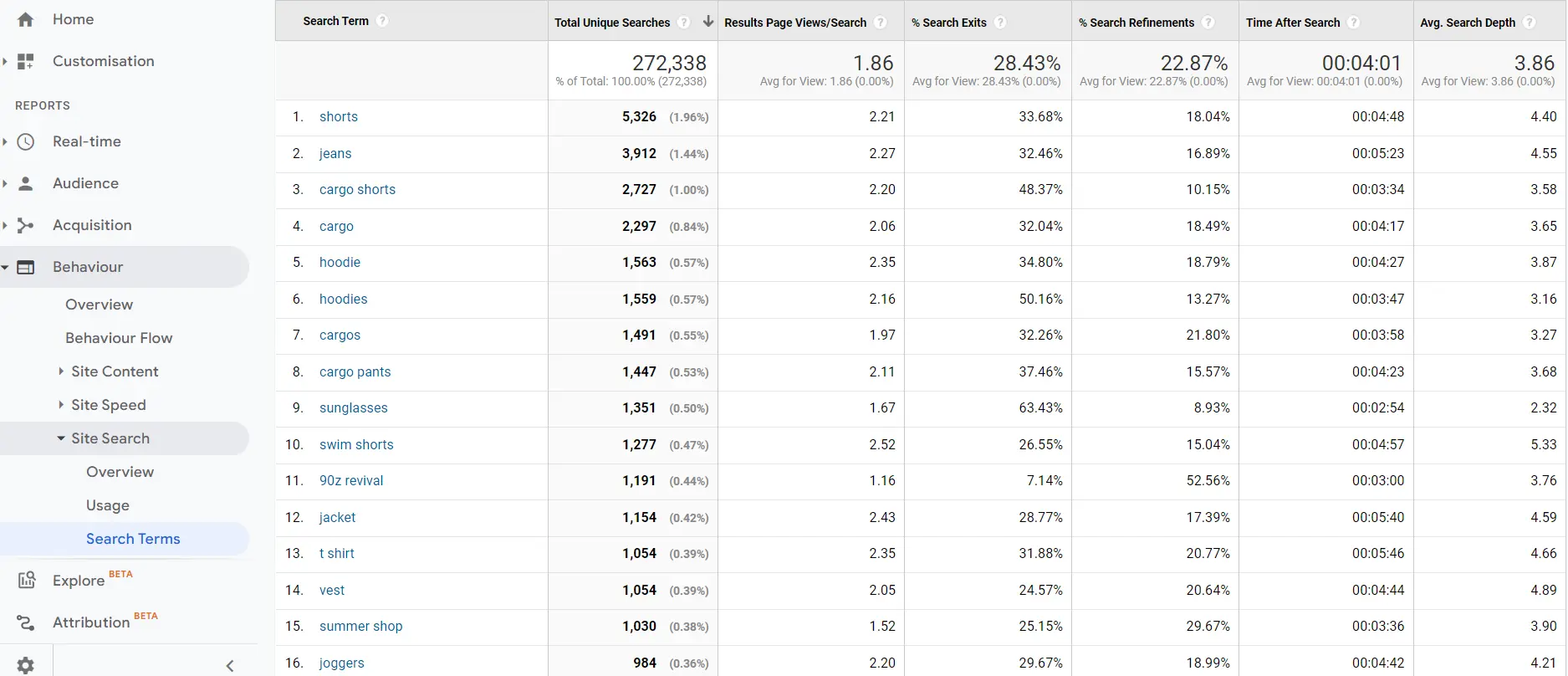
But how can you tell if a keyword is likely to lead to a transaction or merely provide information? To determine if Google considers a keyword as transactional or informational, you can check the Google result for your given keyword and look at who is ranking in the Top 10 positions. If online stores, product pages, or shopping ads dominate the results, the keyword likely has transactional intent. Conversely, if blog posts, articles, or how-to guides feature prominently, the keyword is likely informational.
Moreover, this analysis can alert you to competitors targeting your potential keywords. If a competitor is doing well with a certain keyword, don’t be afraid to play detective again. Investigate what’s working for them by examining their page title, product title, product description, and the way the page is linked within their site.
To sum up, the goal is to unearth long-tail keywords that:
- Accurately represent your products
- Attract a fair number of searches, even if not frequently
- Are considered by Google as transactional
How often should you dive into keyword research?
Regular keyword research is essential for staying up-to-date with changing trends. We see two factors that influence your keyword research frequency:
Demand side: your customers’ tastes and needs are as changeable as the weather. As their preferences morph, fresh opportunities to target new keywords crop up. Let’s say you run an online clothing store targeted towards millennial women. Over time, you notice that your customers’ preferences are shifting toward more sustainable and eco-friendly materials. To stay competitive and address this trend, you conduct keyword research and find that terms like “sustainable clothing,” “eco-friendly apparel,” and “ethical fashion” are gaining popularity.
Tools like Google Analytics’ Search Term report can be a treasure trove of potential keywords. It’s like a window into your users’ minds, showing you what they actually type when searching for products on your site.
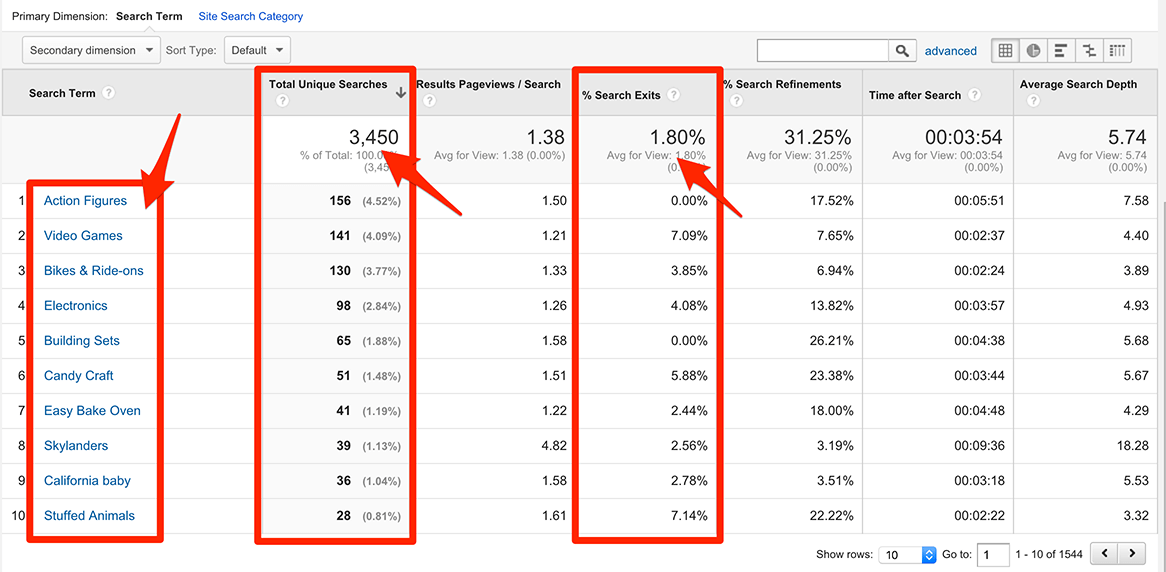
And don’t forget the power of Amazon autocomplete. This feature provides a sneak peek into the phrases and queries used by users on the world’s largest marketplace. Our trick for digging into this goldmine? Create a script that feeds your Google Analytics search terms into Amazon’s search bar and voila! You can see the specific terms users add to your keywords. Don’t worry if coding isn’t your thing – freelancers from platforms like Upwork can help you create such scripts for under $100.

Supply side: as your product range expands and evolves, so should your keywords. For example, if your electronics store starts selling smart home devices, you need to conduct keyword research to uncover relevant terms for these new offerings. You might find “smart home devices,” “voice-controlled speakers,” and “smart security cameras” are the sought-after keywords in this niche.
As a rule of thumb, it’s a good idea to conduct keyword research at least every quarter, or whenever you add a significant number of new products. This keeps your e-commerce website in sync with current trends and well-optimized for search engines.
Remember, regular keyword research is like a compass, helping you navigate the ever-changing seas of e-commerce. So, keep exploring, keep discovering, and stay ahead of the game!
Keyword Difficulty: An Essential Consideration or a Mere Distraction?
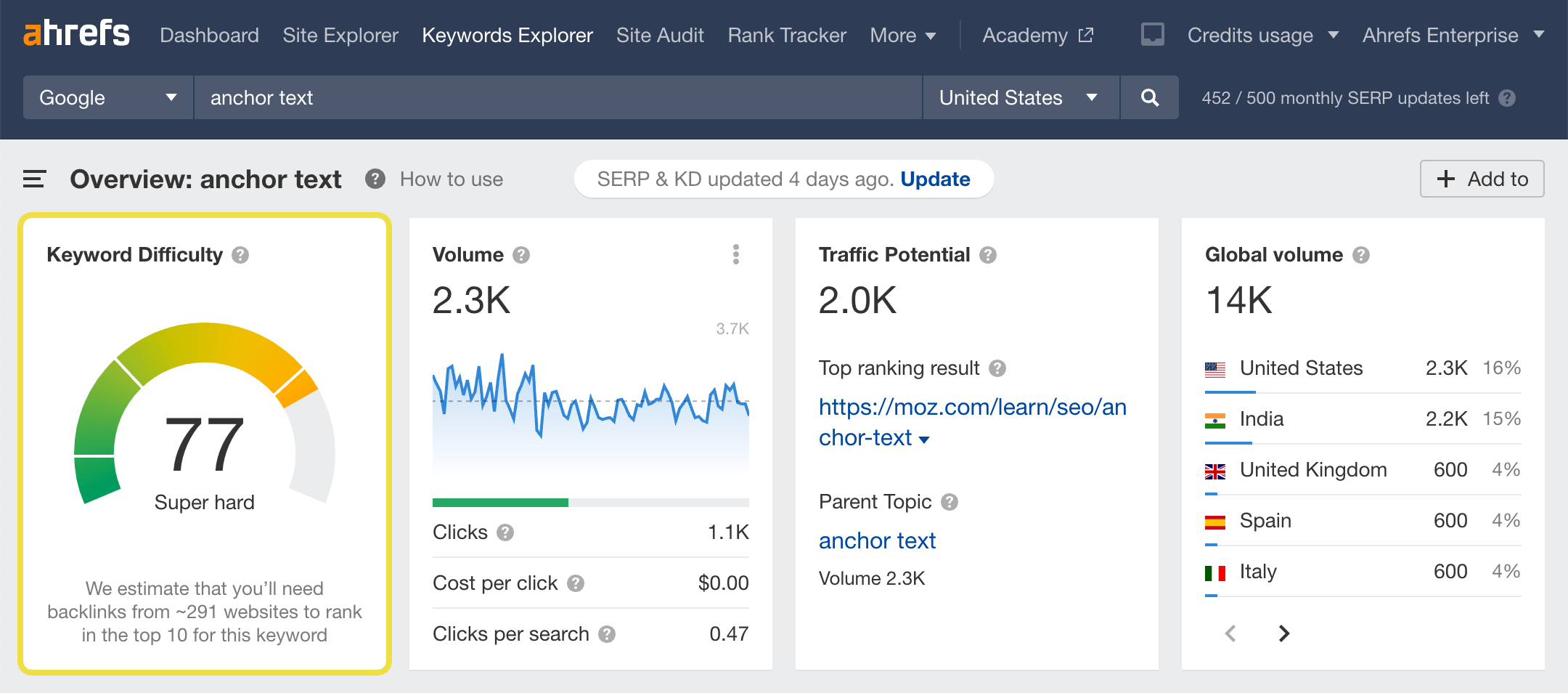
Keyword Difficulty (KD) is a common metric in SEO, reflecting the estimated difficulty to rank organically for a specific keyword. KD scores range from 0 to 100, with higher scores indicating tougher competition. The score primarily depends on the number and quality of websites currently ranking for that keyword.
However, rather than getting entangled in KD scores, it’s more beneficial to focus on these three key considerations:
- Relevance: the first question to ask is, can you create a relevant page for the high KD keyword? If you can deliver a page that matches the user’s search intent perfectly, then don’t hesitate to proceed.
- Search Volume: it’s vital to ensure that there’s sufficient search volume for your high KD keyword. In other words, verify that users are indeed searching for the page your keyword aims to rank for.
- Existing Content: before creating a new page, review your existing content. If you already have a page that could rank for the high KD keyword with some tweaking, then it may be more effective to optimize what you already have.
In summary, don’t let KD scores deter you. Focus instead on relevance, search volume, and making the most of your existing content.
Examples of Ecommerce Keyword Research
To illustrate the process, let’s assume you run an online store selling eco-friendly products. After conducting keyword research, you might identify the following keywords with their respective average monthly search volumes:
- 🌍🧴 “Reusable water bottle” (33,100 searches per month, low difficulty, transactional intent)
- 🌎✅ “Benefits of eco-friendly products” (1,300 searches per month, low difficulty, informational intent)
- 🌱👕 “Organic cotton clothing” (12,100 searches per month, medium difficulty, transactional intent)
By targeting these keywords, you can create content that appeals to your target audience, drives organic traffic, and ultimately boosts conversions.
How to do keyword research for e-commerce?
Keyword research in SEO traditionally starts with a basic term called a “seed keyword.” Tools like Google Keyword Planner or Moz take this seed keyword and generate related terms. This approach is excellent for finding keywords closely linked to the original one, which helps expand the semantic reach of existing pages and enhances the overall SEO strategy.
For e-commerce websites, it’s crucial to strategically map out keywords. This involves diving into your product catalog and identifying every unique product group and the specific user intents they target. By doing so, you can create new category pages, each dedicated to answering a single, specific user search. This method is particularly effective as search engines favor category pages, which offer users a range of product choices and tend to be more stable than individual product pages. Category pages are less affected by stock fluctuations, reducing the likelihood of page issues like redirections or errors. This approach, focusing on “Comprehensive Category Coverage” and “Distinct Search Intent,” ensures that each category page addresses a unique user need, avoiding overlap and redundancy.
Verbolia’s keyword research tool aligns perfectly with this strategy. It starts with your product catalog, breaking down product titles and attributes into keywords. This tool goes a step further by enriching your keyword list with terms from various sources, like internal searches, Google Search Console, and competitor keywords. It checks if you have the right products for these keywords and if there’s sufficient market demand. After removing any duplicate user intents, you’re left with a comprehensive list of keywords for creating dedicated category pages, enhancing your chances of ranking for non-branded, long-tail SEO traffic. This method not only streamlines the process of page creation but also ensures that your pages are optimized to attract the right audience.
About The Author
How can Verbolia help your e-commerce platform.


